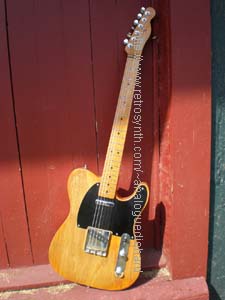Fender Telecaster 1997 '52 Reissue "parts"
Last Update 02/12/2012
Just when I get done complaining about how much I hate cherry picking
for good Fender guitars like Strats
and Jazz
basses - I stumble upon
another good Fender (despite my best efforts to stay out of music
stores, I feel this irresistable *PULL*). The store wasn't sure
whether it was real and they had a good price on it. It obviously
wasn't stock but as far as I could tell it looked authentic. I
got my brother on the cell phone (he's the real guitar slinger of the
family) and he thought it was authentic too. Playing it through
an amp revealed pretty good sounds. The action was quite high -
previous owner probably had it set up for slide. The guitar badly
needed a setup as it wasn't in tune through the neck. It didn't
sound
redundant compared to my Strat or Les Paul so I felt the perpetual
drain on my wallet once more.
I took it to a reputable vintage guitar store and they confirmed that
it was a "parts" guitar but all indications were that the body, neck,
and parts were authentic Fender components. The neck plate,
bridge, tuners, and pots were not original. The tuners are sealed
Grovers which I like. The wiring in the control cavity is
positively the worst solder job I have ever witnessed. There is
an intermittent buzz that will need attention. There is no serial
number anywhere on the
guitar- not on the neckplate, not even on the underside of the
neck. Although the former owner did etch some wisdom on the side
of the guitar on the upper bout, which is the only unique identity of
the guitar. When the neck was removed there was a "1992"
timestamp on the end of the neck, but a label on the underside revealed
a "1997" date so it is the later date. Judging by the position of
the logo and the string tree on the heastock, this was a neck from a
'52 reissue Telecaster. Despite the Fender "spaghetti logo" on
the headstock I thought it was more likely this was a reissue not an
authentic 50's neck, as I was aware that Fender was building reissues
of vintage guitars. The other telltale sign of a reissue was the
roller string guide not the simple screw and ferrule of the 50's
guitars.
According to the store I bought it from, the neck pickup is a Seymour
Duncan "Jerry Donahue" telecaster pickup while the bridge is a Fender
Texas Special. Whether the bridge pickup is overwound like a 50's
bridge pickup
I do not know. These pickups are not stock on a '52
reissue. The bridge
is missing the Fender logo and patent
number stamp so it is not stock, although it does have the triple brass
saddles typical of '52 reissues and is a "B Bender" bridge
with the telltale through hole behind the B string - and someone was
experimenting with benders on the G and D string as there are cutouts
for those strings too.
The body was definitely Fender material judging by its
construction. It likely did come from a '52 reissue as it
originally was a butterscotch finish, although the former owner had
stripped the finish from the top surface (it remains in the wood
grain). It has that "road karma" look to it - hey I'm no snob
about pretty guitars! I don't think the body ever had a sealant
like polyurethane applied to it. The wood has a nice resonance to
it which really helps the guitar get that tele "spank" (strats go
"twang"). The guitar is featherlight - 6.9lbs, the lightest in my
collection. Since ash grows in widely varying densities, there is
a theory that the lighter ash bodies contribute to better tone.
"Better" is highly subjective but I do like the tone of this one.
Different alloy strings make a difference with single coil
pickups. When I bought the guitar I gauged the low E which turned
out to be an 038 - pretty small. But I LIKED the sound of this
set. The store did not know what it was strung with but the
differing colors of the ball ends were the telltale mark of D'Addario
XLs. When I took the guitar to have a setup done and the buzz
fixed, they put 042s
on it. They still have that tele "spank" and the action was MUCH
better.
The neck has that "broken in" feel to it and it plays pretty
fast. I never cared for maple fingerboards but this one is a good
one. The pickups get some interesting variations, especially the
middle position which has this interesting "honk" that is effective for
funky staccoto style playing. The wiring is the later circuit
with master tone and master volume pots. While it is a bright
guitar typical of Telecasters, the tone control does a good job of
taming this for the tone of your taste. This guitar has the
lowest output in my arsenal but Teles were never hot level guitars
anyway.
This is not a guitar for high gain distortion as the pickups squeal too
much. That's typical for a Tele and that explains why single coil
Tele pickups were not seen in Heavy Metal or Modern Rock bands.
But this does offer tones that I couldn't get on my Strat or Les
Paul. I had been leaning towards soul and funk styles and Teles
were the tool of these players. With the addition of this Tele
now I am satisfied with the variety of tones available in my guitar
collection - no more guitar purchases for me (although my brother keeps
tempting me to buy a vintage Gibson). Time to get serious about
saving money to build a house.

Home






